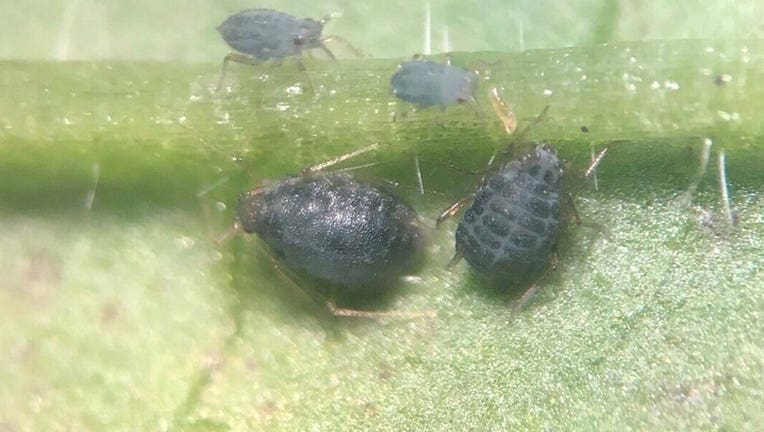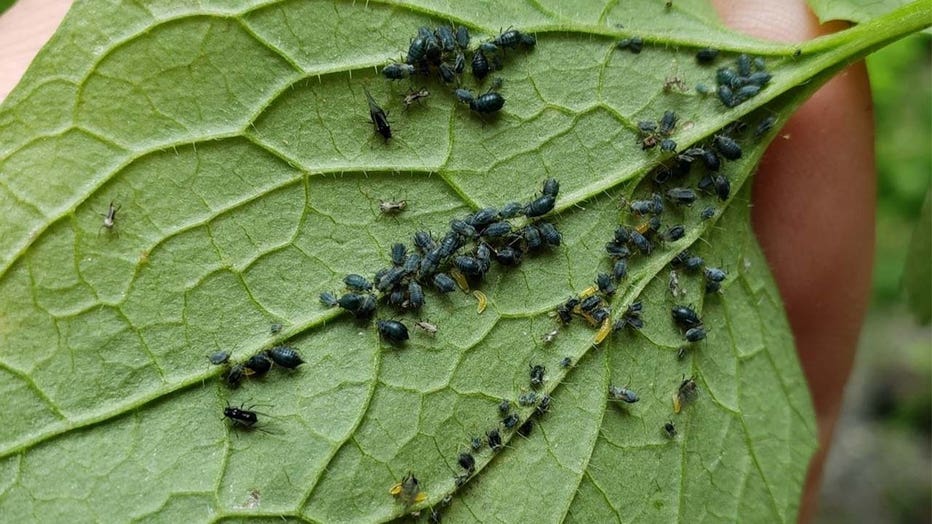Grenade-shaped insect could be key to taking bite out of notorious invasive plant in Michigan

A magnified image of garlic mustard aphids showing their grenade-like coloring and markings. Photo courtesy of Rebecah Troutman, Holden Forests and Gardens. (Photo courtesy of Michigan DNR)
(FOX 2) - They're tiny, shaped like a grenade, and may be Michigan's best chance at cutting back on one of the state's most persistent invasive plants.
Garlic Mustard aphids are considered a minor pest in many of the countries they've been found. However, after they were spotted munching on the bottom of an invasive garlic mustard weed in the Midwest, some researchers are rethinking their role in the local ecology.
Garlic mustard is a ground-level plant that sprouts in the spring. The invasive plant can be tough to manage and is known for out-competing native plants as they spread through soil. It also doesn't discriminate between sunny and shady spots.
The plant does have medicinal uses, which is why it was brought to the U.S. by settlers in the 1800s. Its flavor can also season soups and other foods.
Unfortunately, its edible uses haven't done enough to stamp out it's spread. That's why an Ohio biologist's discovery of an insect eating the plant has brought some hope to efforts seeking to slow garlic mustard.
Rebecah Troutman, who works as a biologist at a park near Lake Erie's coast in Ohio, was pulling out garlic mustard when she noticed the plants.
"I did some Googling and made a preliminary identification of the garlic mustard aphid, Lipaphis alliarae," Troutman said in a release from the Michigan Department of Natural Resources. "I then sent a sample to Doris Lagos-Kutz, research associate at the U.S. Department of Agriculture, who confirmed it was the first official sighting of the European aphid in the U.S."
The observation was also reported in the Midwest Invasive Plant Network, which tracks invasive species.
According to Troutman, the insects appeared to suck the sap from the plants, which causes its leaves to wilt and disrupts its seed pods.
MORE: Scientists want to use the Samurai Wasp to fight Michigan's invasive stink bug problem
Invasive species frequently present issues to local wildlife because there's no predator to keep their populations in check. As they spread without any natural barriers, they can more easily beat out local plants and animals in search of habitat and food.

The underside of a garlic mustard leaf infested with garlic mustard aphids. Photo courtesy of Rebecah Troutman, Holden Forests and Gardens. (Photo courtesy of Michigan DNR)
Wildlife managers tasked with containing non-native plants and animals must also be on the lookout for new species as well. Last year, beech leaf disease and spotted lanternfly were discovered for the first time ever in Michigan.
To confront these issues, creative solutions are often considered - including using other invasive species.
In the case of garlic mustard, the non-native aphids found on some of their leaves led to shorter plants, reduced spread, and "less overall biomass" according to Michelle Beloskur, who works as a coordinator with MIPN.
Since then, there have been isolated reports of the insect feeding on the plant in Connecticut, Massachusetts, Michigan, Minnesota, and Wisconsin.
Invasive species networks are looking for evidence of aphids eating garlic mustard to study if they can be used to reduce the spread of the plant. If anyone in Michigan recognizes the bug, they're asked to report a sighting at EDDMapS.org/Report or on the downloadable EDDMapSApp.

